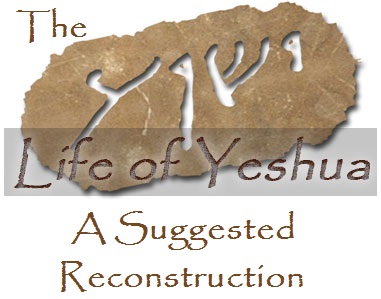How to cite this article:
Joshua N. Tilton and David N. Bivin, “First and Last,” The Life of Yeshua: A Suggested Reconstruction (Jerusalem Perspective, 2024) [https://www.jerusalemperspective.com/28980/].
Matt. 19:30; 20:16; Mark 10:31; Luke 13:30
(Huck 165, 189, 190; Aland 211, 255, 256;
Crook 252, 295, 297)[45]
וְהֲרֵי יֵשׁ אַחֲרוֹנִים שֶׁיִּהְיוּ רִאשׁוֹנִים וְיֵשׁ רִאשׁוֹנִים שֶׁיִּהְיוּ אַחֲרוֹנִים
“Look! There are those in last place who will be put first. And there are those in first place who will be put last.”[46]
| Table of Contents |
|
3. Conjectured Stages of Transmission 5. Comment 8. Conclusion |
Reconstruction
To view the reconstructed text of First and Last click on the link below:
Premium Members and Friends of JP must be signed in to view this content.
If you are not a Premium Member or Friend, please consider registering. Prices start at $5/month if paid annually, with other options for monthly and quarterly and more: Sign Up For Premium
Conclusion
In First and Last Jesus predicted the upsetting of the injustices inherent in the status quo that would come about as a result of the inbreaking of the Kingdom of Heaven.
 Click here to return to The Life of Yeshua: A Suggested Reconstruction main page.
_______________________________________________________
Click here to return to The Life of Yeshua: A Suggested Reconstruction main page.
_______________________________________________________

- [1] See Bundy, 370 §268. ↩
- [2] See Theissen, Gospels, 4; Davies-Allison, 3:60; Snodgrass, 371. Cf. Fleddermann, 690. ↩
- [3] See LHNS, 131 §165, 148 §190; David Flusser, Die rabbinischen Gleichnisse und der Gleichniserzähler Jesus (Bern: Peter Lang, 1981), 68; François Bovon, “Tracing the Trajectory of Luke 13,22-20 Back to Q: A Study in Lukan Redaction,” in From Quest to Q: Festschrift James M. Robinson (ed. Jon Ma. Asgeirsson, Kristin de Troyer, and Marvin W. Meyer; Leuven: Leuven University Press, 2000), 285-294, esp. 290-291. ↩
- [4] Cf. Snodgrass, 371. ↩
- [5] Cf. Bundy, 403 §311. ↩
- [6] See Bovon, 2:309. ↩
- [7] See Kilpatrick, 88; Jeremias, Parables, 35; Gundry, Matt., 395, 398; Luz, 2:535-536. Cf. LHNS, 148 §190. ↩
- [8] Pace Snodgrass (362), who seems to have overlooked the trouble the author of Matthew took to integrate Generous Householder into its present context. ↩
- [9] Cf. McNeile, 285; Jeremias, Parables, 34. ↩
- [10] See C. H. Dodd, The Parables of the Kingdom (rev. ed.; New York: Charles Scribner’s Sons, [1935] 1961), 94; Manson, Sayings, 220; Jeremias, Parables, 37; Albright-Mann, 235; Flusser, Die rabbinischen Gleichnisse und der Gleichniserzähler Jesus, 68; Funk-Hoover, 225; Vermes, Authentic, 146. ↩
- [11] See Manson, Sayings, 220; Bundy, 404-405 §312; Schweizer, 395; Funk-Hoover, 225; Luz, 2:526, 536. ↩
- [12] Cf. Dodd, The Parables of the Kingdom, 94-95. ↩
- [13] Cf. McNeile, 285; Bundy, 404-405 §312; Jeremias, Parables, 36; Flusser, Die rabbinischen Gleichnisse und der Gleichniserzähler Jesus, 68; Luz, 2:536. ↩
- [14] Cf. Bundy, 404-405 §312. ↩
- [15] Cf. Snodgrass, 371. ↩
- [16] Followers of the Two-source Hypothesis typically say that Luke’s version of First and Last is based on Q and that the author of Luke omitted the version he found in Mark. Cf. Streeter, 280; Bundy, 370 §268; Marshall, 568; Bovon, 2:309. But the number of doublets in Luke shows that the author of Luke was not averse to duplicate sayings. From the perspective of Lindsey’s hypothesis, the author of Luke could not have omitted Mark’s version because Mark is based on Luke. ↩
- [17] Cf. A. B. Bruce, 252. ↩
- [18] Cf. Davies-Allison, 3:60. ↩
- [19] See Manson, Sayings, 220; Gundry, Matt., 398. Fleddermann (690) mentions other scholars who share this opinion. ↩
- [20] Cf. Davies-Allison, 3:67. ↩
- [21] Numerous scholars do attribute Matt. 20:16 to Q. See Streeter, 279; Bundy, 404 §312; Marshall, 568; Bovon, 2:309; Fleddermann, 690. ↩
- [22] Cf. Kilpatrick, 88. ↩
- [23] Text according to Bernard P. Grenfell and Arthur S. Hunt, eds. and trans., The Oxyrhynchus Papyri Part IV (London: Egypt Exploration Fund, 1904), 8. ↩
- [24] Cf. Bovon, 3:309-310. ↩
- [25] See McNeile, 283. ↩
- [26] Cf. Gundry, Matt., 398; Fleddermann, 691. ↩
- [27] Cf. Jeremias, Parables, 35 n. 38. The table below shows all of the instances of οὕτως + “will be” in Matthew and the synoptic parallels (if any):
Matt. 12:40 DT = Luke 11:30 Sign-Seeking Generation
Matt. 12:45 DT (cf. Luke 11:26) Impure Spirit’s Return
Matt. 13:40 U Darnel Among the Wheat
Matt. 13:49 U Bad Fish Among the Good
Matt. 20:16 U First and Last
Matt. 20:26 TT (cf. Mark 10:43; Luke 22:26) Greatness in the Kingdom of Heaven
Matt. 24:27 DT = Luke 17:24 Like Lightning
Matt. 24:37 DT = Luke 17:26 Days of the Son of Man
Matt. 24:39 DT (cf. Luke 17:30) Days of the Son of Man
Key: TT = pericope has parallels in all three Synoptic Gospels; DT = Lukan-Matthean pericope; U = verse unique to a particular GospelThe examples of οὕτως + “will be” in Matthew that have agreement from Luke clearly stem from Anth., but in Darnel Among the Wheat and Bad Fish Among the Good οὕτως + “will be” is redactional. Both of these instances appear in the allegorical interpretations of the parables. In Matt. 12:45 the author of Matthew attempted to transform Impure Spirit’s Return into a parable by using οὕτως + “will be” as a sort of application formula. The same usage is what we find in the Matt. 20:16 version of First and Last. ↩
- [28] Cf. LHNS, 131 §165. Pace Plummer (Luke, 348), Marshall (568) and Fleddermann (691), who regarded καὶ ἰδού in Luke 13:30 as redactional. ↩
- [29] On the omission or replacement of ἰδού by the author of Luke (or the First Reconstructor before him), see Friend in Need, Comment to L6. ↩
- [30] See Coming From All Directions, Comment to L10. ↩
- [31] Cf. Fitzmyer, 2:1027; Funk-Hoover, 348. ↩
- [32] Cf. Gundry, Matt., 398. ↩
- [33] See Call of Levi, Comment to L30. ↩
- [34] See Dos Santos, 87. ↩
- [35] See Hatch-Redpath, 1:558. ↩
- [36] See Dos Santos, 7. ↩
- [37] See Hatch-Redpath, 2:1235-1236. ↩
- [38] See Dos Santos, 188. ↩
- [39] Examples of the pairing of רִאשׁוֹן and אַחֲרוֹן are found in Isa. 41:4; 44:6; 48:12; Hag. 2:9; Ruth 3:10; Eccl. 1:11; Dan. 11:29; 1 Chr. 29:29; 2 Chr. 9:29; 12:15; 16:11; 20:34; 25:26; 26:22; 28:26; 35:27. ↩
- [40] Examples of the pairing of רִאשׁוֹן and אַחֲרוֹן in the Mishnah are found in m. Taan. 1:2; m. Yev. 10:3, 4; m. Git. 6:2; m. Avot 5:7; m. Zev. 12:6; m. Neg. 13:12. ↩
- [41]
First and Last
Luke’s Version
Anthology’s Wording (Reconstructed)
καὶ ἰδοὺ εἰσὶν ἔσχατοι οἳ ἔσονται πρῶτοι καὶ εἰσὶν πρῶτοι οἳ ἔσονται ἔσχατοι
καὶ ἰδοὺ εἰσὶν ἔσχατοι οἳ ἔσονται πρῶτοι καὶ εἰσὶν πρῶτοι οἳ ἔσονται ἔσχατοι
Total Words:
13
Total Words:
13
Total Words Identical to Anth.:
13
Total Words Taken Over in Luke:
13
Percentage Identical to Anth.:
100.00%
Percentage of Anth. Represented in Luke:
100.00%
↩
- [42]
First and Last
Mark’s Version
Anthology’s Wording (Reconstructed)
πολλοὶ δὲ ἔσονται πρῶτοι ἔσχατοι καὶ [οἱ] ἔσχατοι πρῶτοι
καὶ ἰδοὺ εἰσὶν ἔσχατοι οἳ ἔσονται πρῶτοι καὶ εἰσὶν πρῶτοι οἳ ἔσονται ἔσχατοι
Total Words:
8 [9]
Total Words:
13
Total Words Identical to Anth.:
6
Total Words Taken Over in Mark:
6
Percentage Identical to Anth.:
75.00 [66.67]%
Percentage of Anth. Represented in Mark:
46.15%
↩
- [43]
First and Last
Matthew’s Markan Version
Anthology’s Wording (Reconstructed)
πολλοὶ δὲ ἔσονται πρῶτοι ἔσχατοι καὶ ἔσχατοι πρῶτοι
καὶ ἰδοὺ εἰσὶν ἔσχατοι οἳ ἔσονται πρῶτοι καὶ εἰσὶν πρῶτοι οἳ ἔσονται ἔσχατοι
Total Words:
8
Total Words:
13
Total Words Identical to Anth.:
6
Total Words Taken Over in Matt.:
6
Percentage Identical to Anth.:
75.00%
Percentage of Anth. Represented in Matt.:
46.15%
.
First and Last
Matthew’s Anth. Version
Anthology’s Wording (Reconstructed)
οὕτως ἔσονται οἱ ἔσχατοι πρῶτοι καὶ οἱ πρῶτοι ἔσχατοι
καὶ ἰδοὺ εἰσὶν ἔσχατοι οἳ ἔσονται πρῶτοι καὶ εἰσὶν πρῶτοι οἳ ἔσονται ἔσχατοι
Total Words:
9
Total Words:
13
Total Words Identical to Anth.:
6
Total Words Taken Over in Matt.:
6
Percentage Identical to Anth.:
66.67%
Percentage of Anth. Represented in Matt.:
46.15%
↩
- [44] Cf. Culpepper, 375. ↩
- [45] For abbreviations and bibliographical references, see “Introduction to ‘The Life of Yeshua: A Suggested Reconstruction.’” ↩
- [46] This translation is a dynamic rendition of our reconstruction of the conjectured Hebrew source that stands behind the Greek of the Synoptic Gospels. It is not a translation of the Greek text of a canonical source. ↩





